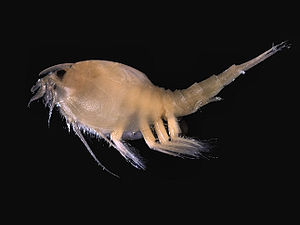Leptostraca
| Leptostraca | ||||||||||||
|---|---|---|---|---|---|---|---|---|---|---|---|---|

|
||||||||||||
| Systematics | ||||||||||||
|
||||||||||||
| Scientific name | ||||||||||||
| Leptostraca | ||||||||||||
| Claus , 1880 |
The Leptostraca are an order of the higher crustaceans (Malacostraca). They are the only living order of the subclass Phyllocarida. Two other orders, the Archaeostraca and the Hoplostraca , are extinct.
Systematics
The systematic position of the Phyllocarida has long been controversial. The crustacean specialist Henri Milne Edwards assigned them to the gill pods (Branchiopoda) because of their two-part carapace . Only after the embryonic development of the phyllocarida had been examined, which corresponds to that of the higher crustaceans, and chiltin ridges had been discovered in the gizzard, were they placed with the Malacostraca.
There are about 20 species, of which one belongs to the families Nebaliopsidae and Paranebaliidae . The others belong to the Nebaliidae .
anatomy
The carapace of the leptostraca is only connected to the head. The thorax , which consists of eight segments, can be moved freely in it. At the front end of the carapace there is a movable rostral plate, under which the complex eyes, which sit on stalks, sit on both sides . At the maxilla there is a brush-like, rearward-facing organ with which the carapace inside and the thorax can be unified. The Leptostraca have two pairs of unfeathered antennae that are carried downwards and backwards. At the end of the thorax there is a steadily tapering tail stalk consisting of seven segments.
Way of life
Most of the Leptostraca live on the seabed, from the coast to depths of 400 meters, and sieve their detritus food from the soft digested sludge. Nebaliopsis typica , the only species in the Nebaliopsidae family, lives bathypelagically in warm seas. Two other species live in the deep sea.
literature
- Hans-Eckhard Gruner et al .: Urania Tierreich, Invertebrates 2. Urania-Verlag Leipzig, Jena, Berlin, ISBN 3-332-00502-2
